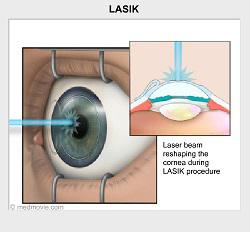Lasik Story

Lasik Story
A bright-eyed college senior, I sat in the leather exam room chair for my first LASIK consult. I had chosen the nearest ophthalmologist in my small town, to evaluate my candidacy. “Do you have any questions for me?”, the doctor asked as he twisted off the cap on the bottle of eye drops. My mind went blank- “I can’t think of any questions…”
As I waited in the room for my eyes to dilate, I typed into my phone “Questions to ask my doctor about LASIK” and was inundated by a list of blurry points to discuss when he returned. Fifteen minutes later, he shined a bright light into my eyes, asking if I had a familial history of glaucoma. I shook my head and shrugged. With a sigh, he explained to me about the diagnosis of glaucoma. In an instant, my plans for LASIK had dissipated as he encouraged selective laser trabeculoplasty and handed me an informational pamphlet. “How many of these procedures have you performed?”, I asked, fiddling with the stack of papers in my hand. Confidently, he reported “I’ve completed hundreds of these surgeries… I’ve lost count.” “Do you think I should get a second opinion?” I asked. “If you want to,” he responded, “but I’m fairly confident in this diagnosis.” He stepped out of the exam room and I heard him tell the receptionist “Not a LASIK consult anymore; it’s a glaucoma evaluation.” I walked out of the office with confusion, shock, and a surgery appointment card.

Because of the looming wave of COVID-19 cases, I later received a call from the doctor’s office to reschedule my procedure, as they postponed all non-emergency cases. My roommate recommended that I seek a second opinion and sung praises of her family ophthalmologist who practiced 1.5 hours away. Three months later, we took a trip together to the big city and visited the much larger ophthalmology facility. After several diagnostic tests, the doctor notified me that I do not have glaucoma and do not need surgical intervention. Explaining the indecipherable results in his hands, he educated me about congenitally large optic discs, a more common finding in my ethnic group.
Looking back on this experience, my naivety was saved by word-of-mouth and access to a provider experienced in diverse populations. I avoided spending thousands of dollars on a needless surgery. I couldn’t help but wonder about the hundreds of potentially misdiagnosed patients who underwent this procedure unnecessarily. Patients like me need resources to find the best doctor and guidance to be able to ask the right questions.
